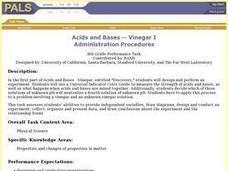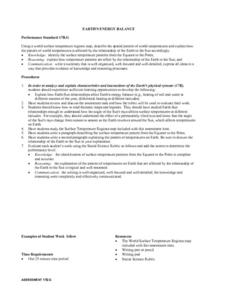Teach Engineering
Microbes Know How to Work!
Scholars harness the power of microbes with an engaging activity that uses yeast to break down sugar in water. Multiple setups of the same experiment lets learners determine which temperature results in the fastest rate of sugar...
Mr. Beem's Social Studies
Civil Rights Project: The Long Civil Rights Movement
Investigate milestones along the path that lead to the American Civil Rights Movement of the 1960s. After researching key people, events, court cases, and legislative orders, teams present their findings as a magazine, newspaper, or...
California Department of Education
Name That Job!
Can you name the job that involves scholars, classes, and grades? If you guessed teacher, you just won a round of Name That Job! The second lesson in a five-part college and career readiness unit has career seekers team up and go head to...
Curated OER
Conventions Self-Check Sheet
Fifth graders study conventions in writing. In this grammar lesson plan, 5th graders listen to samples with appropriate conventions and samples without appropriate grammar and determine which are appropriate. Students self-assess their...
Curated OER
Money and Business
Third graders use play money to complete tasks that allow them to see if the budget they came up with works. In this budget lesson plan, 3rd graders create their own budget and test it out with the play money.
Curated OER
Corn Husk Doll
Students practice melody and lyrics and the feelings they represent, in two languages, sing the melody of the Corn Husk Doll, lyrics Maria Hinton, melody by Patti Morin in Oneida, and discuss how the words to this song demonstrate...
Curated OER
SENSORY ELEMENTS
Students describe the sensory elements of musical selections (i.e., tempos, dynamics, and articulations). They write an essay evaluating Saint-Saens' effectiveness in using sensory elements in both selections. They describe the...
Curated OER
EXPRESSING AN IDEA
Students explain how elements (body, space, time, and force) can be contrasted to express anger and happiness in movement. They give examples for each of the elements: body actions, speed and force of movement. They display their...
Curated OER
Illustration # 5: Phone Number Melodies
Fourth graders create their own melodies by making up a phone number with the numbers of the C major scale (the number 9 will be played by double the C at an octave. Students are encouraged to end their piece with V, I progression in...
Curated OER
CREATE A NEW RHYME
Third graders develop basic narratives. They retell a focused story and create a basic publication using available resources (e.g., pictures, colors, computer, copier). They experiment with different forms of creative writing (e.g.,...
Curated OER
Watch Your Conductor Like a Hawk
Students focus their eyes on the conductor in music class. The teacher uses a music sheet to isolate the musical elements of tempo, balance, and blend.
Curated OER
Ellis Wilson: A High School Art Lesson
Students study the principles of design and element of the art of Ellis Wilson. They examine how art can create social commentary.
Curated OER
Ellis Wilson: An Elementary School Art Lesson
Young scholars study the life of Ellis Wilson. They examine the use of simple shapes when drawing human figures. They examine how to incorporate pattern into a background setting.
Curated OER
You've Got Rhythm
Students study the rhythm value of a half note, quarter note, whole note, and eighth note. They stamp a rhythm pattern and create a clay animation which demonstrates note value.
Curated OER
Sow Bug Habitats
Students conduct an experiment to determine what type of environment sow bugs prefer. They use petri dishes with partially wet paper towels to assess whether they prefer wet or dry habitats.
Curated OER
Acids And Bases -- Universal Indicator
Eighth graders design and perform an experiment that uses a Universal Indicator Color Guide to measure the strength of acids and bases. They also determine happens when acids and bases are mixed together. They decide which of three...
Curated OER
Here's Looking at You
High schoolers assess some common inherited traits which are easily observable and note their phenotype for the trait. Students compare their phenotypes to those of their parents and attempt to describe the pattern and manor of inheritance.
Curated OER
Mythical Animals
Students create imaginary animals by assembling pictures of body parts from pictures of real animals. This is one of three linked tasks. The others are "Who's Parts Do I Have?" and "Animals Piece by Piece."
Curated OER
Earth's Energy Balance Performance Standard
Students examine how Earth-Sun relationships affect Earth's energy balance and the pattern of world temperatures. Students study a Surface Temperature Regions map and write a paragraph describing the temperature pattern from the Equator...
Curated OER
Scientific Tools
Students list different uses for common scientific instruments. They identify appropriate instruments to measure length, temperature, and mass. Pupils are given a copy of the "Science Tools" task sheet, students place the correct number...
Curated OER
Exploring Multiplication and Division at a Party
Students solve multiplication and division problems using Unifix cubes. They explore multiplication and division through equal grouping of objects and sharing. Students discuss the task they completed and share how they completed the...
Curated OER
Formal VS. Informal
Middle schoolers each get a copy of the "Formal vs. Informal" task sheet. They read the sentences twice and students put a check mark in the appropriate column on the task sheet. Middle schoolers explain orally why the form of address...
Curated OER
Hockey Hoop Dribble
Students refine/develop hockey dribbling and puck handling skills. They begin by dribbling in general space and perform the following task when they approach the hula hoops:yellow hoop: dribble slowly one time around, green hoop:...
Curated OER
Building a Literature Pyramid
Pupils create a literature pyramid. They review and discuss their assessment task and rubric and select the literature for their pyramid. They read the literary selection and complete a pyramid sheet for one of the four literary...

























